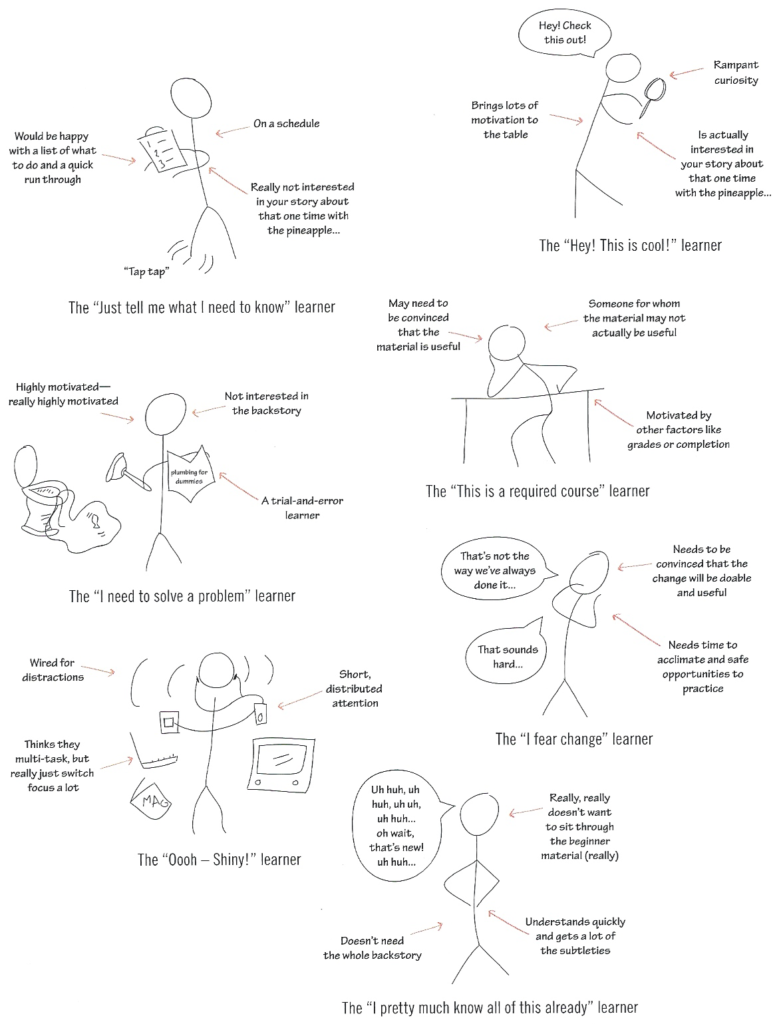Learner analysis
These notes are part of a series for the book.
Outline
- What do your learners want?
- What is their current skill?
- How are your learners different from you?
- Learning styles
- Methods for learning about your learners
- Summary
Notes
This book has great drawings, and here’s an example — seven types of learners and why they are there:

(Dirksen, 2012, p. 29)
You need to know: Learner motivations
Learner motivation can come from within or from without:
- Intrinsically motivated: Wants to learn the information for their own knowledge or to solve a problem. Designing for this person is much easier. Strategies:
- It’s ok to have activities that everyone needs to do, but also make time for these learners to work on their own problems and apply the new knowledge to their own context.
- Encourage these learners to discuss and teach the new information to others.
- Extrinsically motivated: Wants to learn because of external rewards or punishments. Designing for this person is harder. Strategies:
- During learner analysis, look hard for any intrinsic motivator or any problems they face that can be lessened by the training.
- Be sure to tie everything to real-world situations and tasks. Remove all theoretical or background information or move it to an appendix.
- Start with some kind of challenge that is difficult to solve, to provide an intrinsic motivation.
Either way, don’t quash the motivation. Remember that learning is risky, so encourage learners by lowering the stakes. Explicitly build on their current knowledge, make the first activities easier so they have early successes, and make any assessment private or at least not judgmental.
You need to know: Interests
If the learners have a common interest then you can build on that in the learning design.
You need to know: Skill level
You need to know the learners’ current skill level so you can gauge the effort they will need to expend to learn the new information. Current skill level affects the level of instruction you should provide and also the approach you would use. Usually, the learners will have varying skill levels which means trying to meet the needs of all the groups. In this case, some design strategies are:
- Make some parts of the course optional, so people can skip to what they need. This means face-to-face courses may have take-home material; and elearning courses allow fast-forwarding. Consider letting people test out of the course, but only if you are sure that you can provide a pre-test that tests against the learning objectives.
- Make all the resources available to the learners. You may need to help novices identify what they need, but more expert people likely can find the material that helps them best.
- Establish more experienced learners as mentors or coaches, or ask them to share their expertise in ways that benefit the more novice learners.
- For very complex content, use scaffolding techniques. For novices, simplify the environment, provide step-by-step guidance, and provide reference materials and examples.
- Help the learners build mental models by providing outlines and organizers, visuals and graphics, metaphors and analogies, stories and case studies, and problems they can solve.
- Design interactions between the instructor and learners so that any misunderstandings are discovered right away.
You don’t need to know: Learning styles
The research doesn’t back up the usefulness of learning styles (for example, Gardner’s Multiple Intelligences, the VARK model, or Kolb’s Learning Styles Inventory). But, when designing you should generally be aware that people learn differently and are better and different things. Vary your approaches in the design.
How to do it: Introduce yourself
Most instructional designers will talk with stakeholders, trainers, managers, and subject-matter experts, but don’t talk with learners. You need to talk with the learners because they are the best people to tell you:
- Their motivations
- How things actually work, and where there are areas of difficulty
- What they already know, what they want to know, what’s easy for them to learn, what’s been hard for them to learn
- Stories and examples from their context, including the typical scenarios and the exceptions
In addition to talking with them, you can also do job shadowing (following them to observe them in their context), and try new tools or processes alongside them during pilot tests and user testing.